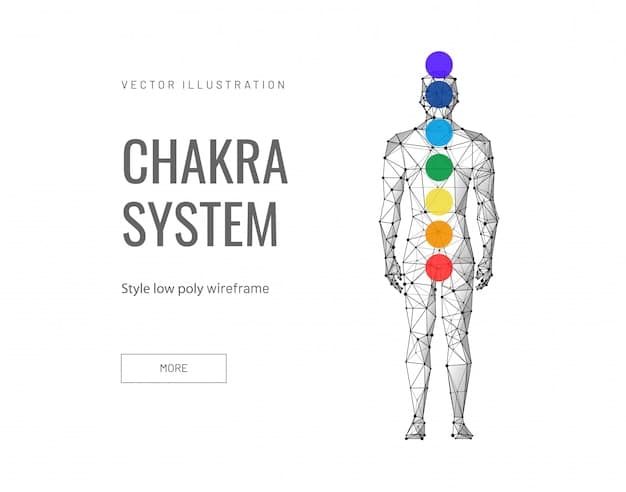Chakras Explained: Your Ultimate Guide to Balancing Energy Centers

Understanding the Chakras: A Comprehensive Guide to Balancing Your Energy Centers delves into the seven primary energy centers of the body, exploring their functions, imbalances, and techniques for restoring harmony and well-being.
Embark on a journey of self-discovery as we explore understanding the chakras: a comprehensive guide to balancing your energy centers. Discover how these vibrant energy hubs influence your physical, emotional, and spiritual well-being, and learn practical techniques to harmonize them for a more fulfilling life.
What are Chakras? An Introduction to the Energy System
Chakras are often described as spinning wheels of energy within the body. They are vital components of our energetic anatomy, influencing various aspects of our well-being.
These energy centers, originating from ancient Indian traditions, play a crucial role in how we experience the world around us. Let’s delve deeper into their significance and function.
Understanding Chakra Locations and Functions
Each chakra is located along the spine, from the base to the crown of the head. Each corresponds to specific organs, emotions, and psychological states.
Here’s a quick overview:
- Root Chakra (Muladhara): Grounding, security, survival. Located at the base of the spine.
- Sacral Chakra (Swadhisthana): Creativity, pleasure, sexuality. Located in the lower abdomen.
- Solar Plexus Chakra (Manipura): Personal power, confidence, will. Located in the upper abdomen.
- Heart Chakra (Anahata): Love, compassion, connection. Located in the center of the chest.

The chakras are more than just energy points; they are integral to how we process emotions, interact with others, and manifest our desires. When these energy centers are balanced, we experience a sense of wholeness and well-being.
The Seven Primary Chakras: A Detailed Exploration
Let’s explore each of the seven primary chakras in more detail, understanding their unique attributes and how they impact our lives.
Each chakra has a specific color, element, and set of associated characteristics. Understanding these can help us to identify imbalances and work towards restoring harmony.
The Root Chakra (Muladhara): Grounding and Security
The Root Chakra, located at the base of the spine, is associated with grounding, security, and survival instincts. A balanced Root Chakra provides a sense of stability and connection to the earth.
- Color: Red
- Element: Earth
- Balanced: Feeling safe, secure, and grounded.
- Imbalanced: Anxiety, fear, insecurity.
The Sacral Chakra (Swadhisthana): Creativity and Pleasure
The Sacral Chakra, located in the lower abdomen, is linked to creativity, pleasure, and sexuality. A balanced Sacral Chakra allows us to experience joy, passion, and healthy relationships.
- Color: Orange
- Element: Water
- Balanced: Creative, passionate, and joyful.
- Imbalanced: Emotional instability, lack of creativity, fear of intimacy.
These are just the first two; keep reading to discover the rest.
Identifying Chakra Imbalances: Recognizing the Signs
Chakra imbalances can manifest in various ways, impacting our physical, emotional, and mental health. Recognizing these signs is the first step towards restoring balance.
Understanding the symptoms associated with each chakra can provide valuable insights into our overall well-being. Let’s explore some common signs of imbalance.
Physical Symptoms of Chakra Imbalance
Physical symptoms can often be a direct result of an imbalance in one or more chakras. For example, a blocked Root Chakra might manifest as lower back pain or fatigue, while an imbalanced Heart Chakra could lead to heart problems or asthma.
Pay attention to these physical cues:
- Digestive Issues: Imbalance in the Solar Plexus Chakra.
- Headaches: Imbalance in the Third Eye Chakra or Crown Chakra.
- Sore Throat: Imbalance in the Throat Chakra.
Emotional and Mental Symptoms
Emotional and mental symptoms are equally important to consider. An overactive Sacral Chakra might lead to emotional dependency and obsession, while a blocked Throat Chakra could manifest as difficulty expressing oneself.

Check in with your emotional state and be mindful of the signs.
Techniques for Balancing Your Chakras: Practical Methods
Balancing techniques can aid in the restoration of the natural flow of energy through your chakras.
There are numerous techniques that can be used to balance your chakras, from simple meditation to more advanced practices. Let’s explore a few effective methods.
Meditation and Mindfulness
Meditation and mindfulness are powerful tools for bringing awareness to your chakras and promoting balance. Simple guided meditations can help you visualize each chakra, clear blockages, and restore harmony.
Try a simple chakra meditation:
- Find a quiet space: Sit comfortably and close your eyes.
- Visualize each chakra: Starting with the Root Chakra, visualize its color and location.
- Breathe deeply: Focus on your breath and imagine it flowing through each chakra, clearing any blockages.
Yoga and Physical Exercise
Yoga and physical exercise can also be highly effective in balancing your chakras. Certain yoga poses are specifically designed to open and stimulate each energy center.
Consider these poses:
- Root Chakra: Mountain Pose (Tadasana).
- Sacral Chakra: Hip-opening poses like Pigeon Pose (Eka Pada Rajakapotasana).
- Solar Plexus Chakra: Warrior Poses (Virabhadrasana).
In addition, lifestyle and diet changes go a long way to help.
Lifestyle and Diet: Supporting Chakra Balance
Our lifestyle and diet play a significant role in maintaining balanced chakras. Making conscious choices about what we consume and how we live can greatly enhance our energetic well-being.
Incorporating specific foods, colors, and activities into our daily routine can support the health of our chakras. Let’s look into ways to support chakra balance.
Foods for Chakra Balance
Certain foods are associated with each chakra, based on their color and energy. Incorporating these foods into your diet can help nourish and balance your energy centers.
Here are some examples:
- Root Chakra: Root vegetables like beets, carrots, and potatoes.
- Sacral Chakra: Orange fruits like oranges, mangoes, and apricots.
- Solar Plexus Chakra: Yellow foods like corn, bananas, and lemons.
Colors and Activities
Surrounding yourself with colors and engaging in activities that resonate with each chakra can also be beneficial. Wearing red clothing, spending time in nature, and engaging in grounding activities like gardening can support the Root Chakra.
Being intentional about food and lifestyle choices can greatly aid you on your path.
Advanced Chakra Practices: Deeper Exploration
For those seeking a deeper understanding of the chakras, there are several advanced practices that can be explored. These practices require dedication and a willingness to delve into the subtle energies of the body.
Practices such as Reiki, crystal healing, and sound therapy can provide profound healing and balancing effects on the chakra system. Let’s explore these methods.
Reiki and Energy Healing
Reiki is a form of energy healing that involves channeling universal life force energy to promote healing and balance. A trained Reiki practitioner can help clear blockages in the chakras and restore the natural flow of energy.
Reiki promotes natural healing:
- Promote relaxation: Reiki can help reduce stress and tension.
- Clear energy blockages: Reiki aims to free up stuck energy.
- Support overall well-being: Reiki is frequently used in conjunction with other therapies.
Crystal Healing and Sound Therapy
Crystal healing involves using the unique properties of crystals to balance and align the chakras. Each crystal is associated with a specific chakra and can be placed on or around the body to promote healing.
Crystals and sound:
- Amethyst: Associated with the Crown Chakra, promoting spiritual connection.
- Rose Quartz: Associated with the Heart Chakra, fostering love and compassion.
- Tuning Forks: Using tuning forks tuned to specific frequencies can also help balance the chakras and promote healing through sound vibration.
Advanced practices should be done with someone experienced in chakra balancing.
| Key Point | Brief Description |
|---|---|
| 🌱 Root Chakra | Grounding, security, survival; located at the base of the spine. |
| 🧡 Sacral Chakra | Creativity, pleasure, sexuality; located in the lower abdomen. |
| 💛 Solar Plexus Chakra | Personal power, confidence, will; located in the upper abdomen. |
| 💚 Heart Chakra | Love, compassion, connection; located in the center of the chest. |
Frequently Asked Questions
▼
Chakras are energy centers in the body that correspond to specific organs, emotions, and physiological states. They are vital components of our energetic anatomy, influencing our overall well-being.
▼
Signs of imbalanced chakras can manifest as physical symptoms such as digestive issues or headaches, as well as emotional symptoms like anxiety, fear, or difficulty expressing oneself.
▼
Simple techniques include meditation, mindfulness practices, and incorporating chakra-specific colors and foods into your daily routine. Yoga and regular physical exercise can also be beneficial.
▼
Yes! Certain foods are associated with each chakra based on their color and energy. Eating these foods can help nourish and balance your energy centers, enhancing your overall well-being.
▼
Yes, advanced practices include Reiki, crystal healing, and sound therapy. These techniques should be explored with trained practitioners to ensure safe and effective balancing of the chakra system.
Conclusion
Understanding and balancing your chakras can lead to a more harmonious and fulfilling life. By incorporating these practices into your daily routine, you can enhance your physical, emotional, and spiritual well-being.





